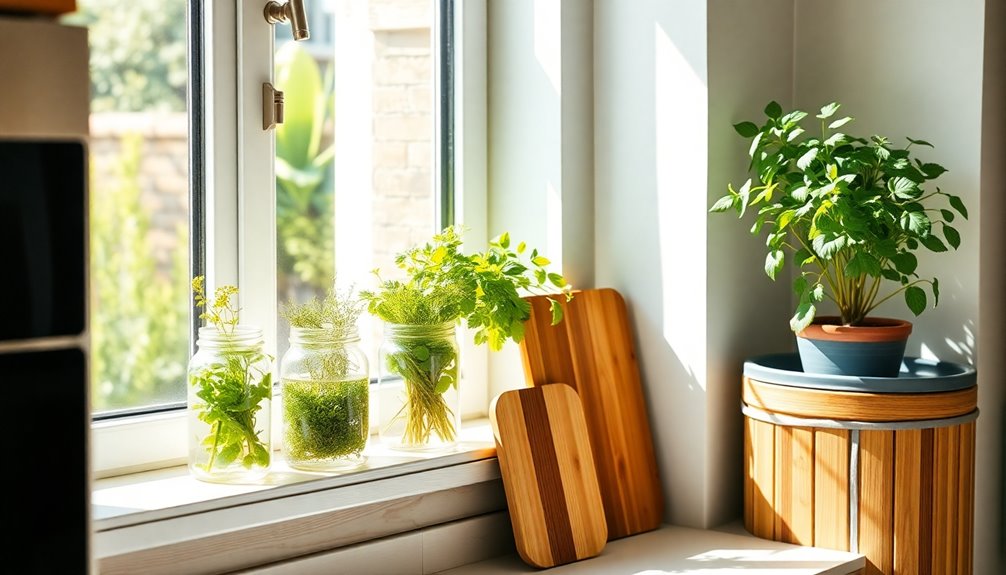You can easily make your home more eco-friendly by implementing a few genius hacks. Start by choosing sustainable materials, like bamboo or reclaimed wood, for your furniture and flooring. Upgrade to energy-efficient LED lighting to save on bills. Install low-flow fixtures to conserve water and consider drought-tolerant plants for your garden. Don't forget to improve your home insulation, which can greatly reduce energy loss. Regularly maintain your HVAC systems for efficiency, and opt for low-VOC products to enhance indoor air quality. Supporting eco-friendly brands also goes a long way. There's plenty more you can do, so stick around for additional tips!
Key Takeaways
- Switch to LED lighting to reduce energy consumption by up to 75% and lower your electricity bills.
- Seal air leaks in your home to save up to 20% on energy costs and improve overall insulation efficiency.
- Use low VOC products and natural materials to enhance indoor air quality and minimize harmful emissions.
- Implement rainwater harvesting systems to conserve water and reduce dependence on municipal supplies for outdoor use.
- Choose eco-friendly brands that prioritize sustainable materials, minimal packaging, and ethical labor practices in their supply chains.
Choose Sustainable Materials
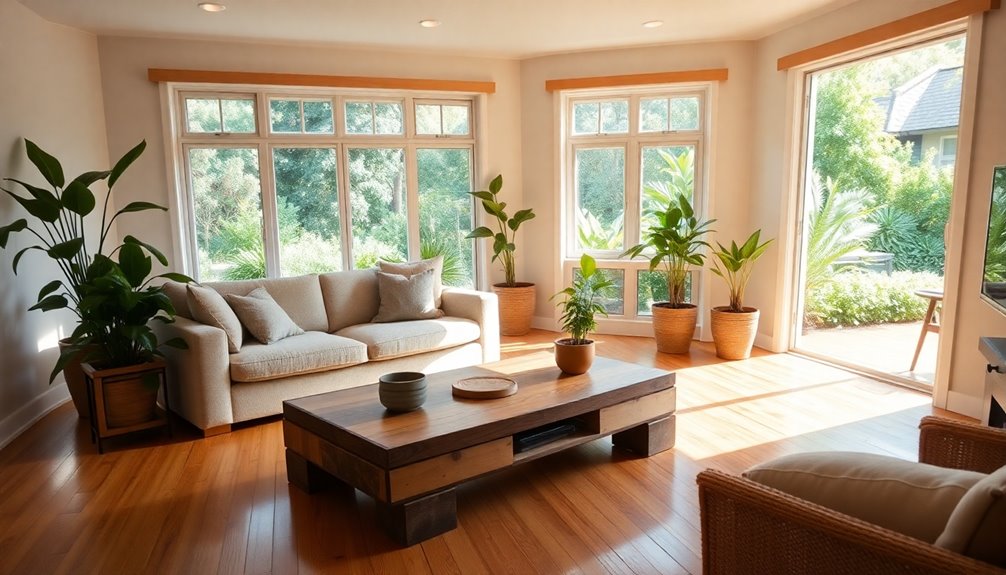
When you choose sustainable materials for your home, you're not just making a stylish choice; you're also improving indoor air quality and reducing your environmental footprint.
Opt for low VOC finishes and non-toxic paints to cut down on harmful emissions. Sustainable flooring options like bamboo and cork are renewable and energy-efficient alternatives to traditional hardwoods.
For textiles, go for natural fibers such as organic cotton or hemp, which lessen the impact of synthetic materials. Furniture made from reclaimed wood or recycled materials minimizes waste and supports a circular economy.
Finally, invest in eco-friendly insulation like sheep's wool or cellulose to boost energy efficiency while being biodegradable. Each choice you make contributes to a healthier home and planet. Additionally, incorporating air purifiers with HEPA filtration can further enhance indoor air quality by effectively removing allergens and pollutants.
Upgrade to Energy-Efficient Lighting
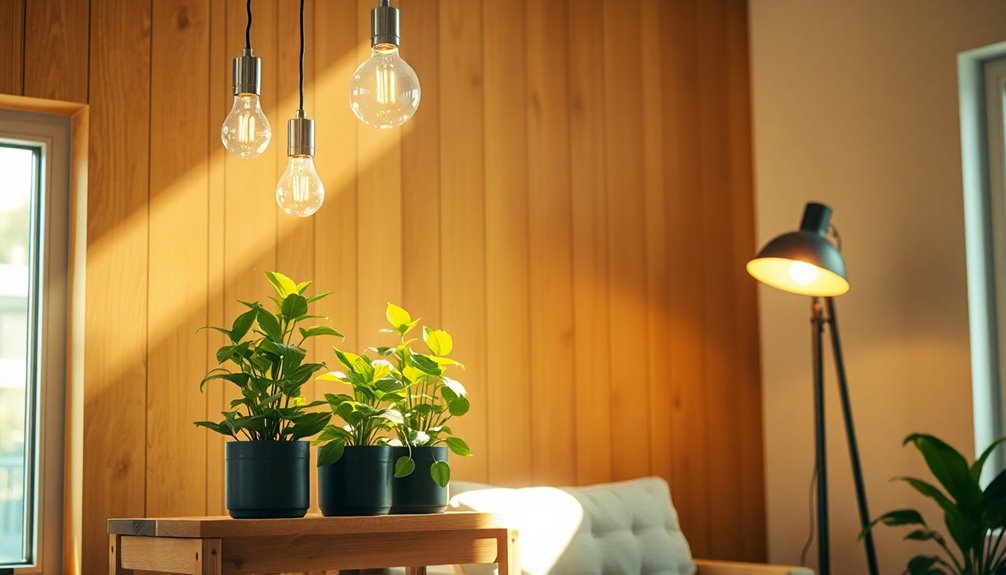
Upgrading to energy-efficient lighting not only brightens your home but also greatly cuts down on your energy bills. By switching to LED bulbs, you can reduce energy consumption by up to 75% compared to traditional incandescent bulbs.
This change can save you an average of $100 or more annually, depending on your usage and local electricity rates. Plus, LED bulbs last about 25,000 hours—25 times longer than incandescent bulbs—so you won't be replacing them frequently.
They also emit less heat, keeping your home cooler and further lowering air conditioning costs. Many energy-efficient bulbs now come with smart technology, letting you control lighting remotely and optimize usage based on your schedule. Additionally, integrating renewable energy sources into your home can further enhance your energy savings and eco-friendliness.
It's a win-win for your wallet and the environment!
Install Water-Saving Fixtures
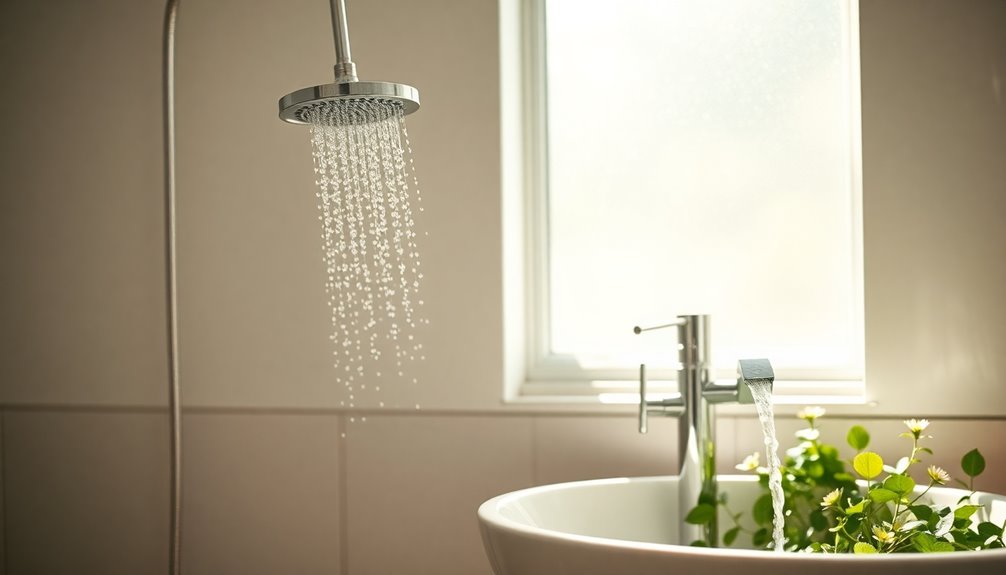
By installing water-saving fixtures, you not only reduce your household's environmental impact but also cut down on monthly water bills.
Simple upgrades make a big difference, and you'll be amazed at how much water you can conserve. Here are three effective options:
- Low-Flow Toilets: These can reduce water usage by up to 60%, saving around 13,000 gallons annually.
- Low-Flow Showerheads: Upgrade to models that save up to 2.5 gallons per minute, greatly cutting your water and energy costs.
- Water-Saving Faucets: Opt for faucets that cut water flow by 30% or more, maintaining performance while conserving water.
Making these changes not only benefits the planet but also your wallet! Additionally, improving your home's overall well-being can further enhance your living environment by promoting better health and comfort.
Incorporate Drought-Tolerant Plants

Incorporating drought-tolerant plants in your garden can greatly cut down on water usage while boosting your home's eco-friendliness.
These plants, like succulents and lavender, not only thrive on minimal moisture but also support local wildlife and enhance soil health.
Let's explore the best varieties that will flourish in your landscape and the benefits they bring.
Benefits of Drought-Tolerant Plants
While many homeowners seek beautiful gardens, choosing drought-tolerant plants offers significant benefits that go beyond aesthetics.
These hardy plants not only enhance your landscape but also support sustainability efforts. Here are three key advantages:
- Water Conservation: Drought-tolerant plants can reduce water usage by up to 50%, helping you save on water bills and conserve this precious resource.
- Low Maintenance: Often native to your local climate, these plants require less care, making them resilient against local pests and diseases.
- Biodiversity Boost: Incorporating these plants promotes habitats for local wildlife, enhancing your garden's ecosystem and supporting a healthier environment. Additionally, solar energy can be utilized to power irrigation systems, further enhancing the sustainability of your garden.
Best Drought-Tolerant Varieties
Transforming your garden into a drought-tolerant paradise starts with selecting the right plants. Here are some of the best varieties you can incorporate:
| Plant Type | Examples | Benefits |
|---|---|---|
| Succulents | Agave, Aloe | Minimal watering needs |
| Native Grasses | Blue Grama, Buffalograss | Supports wildlife, low maintenance |
| Perennials | Lavender, Salvia | Attracts pollinators |
| Ornamental Plants | Red Yucca, Desert Marigold | Adds color, little irrigation needed |
| Edible Plants | Rosemary, Thyme | Culinary uses, reduced watering |
Incorporating native plants into your garden can further enhance its sustainability and resilience against drought conditions.
Utilize Smart Home Technology
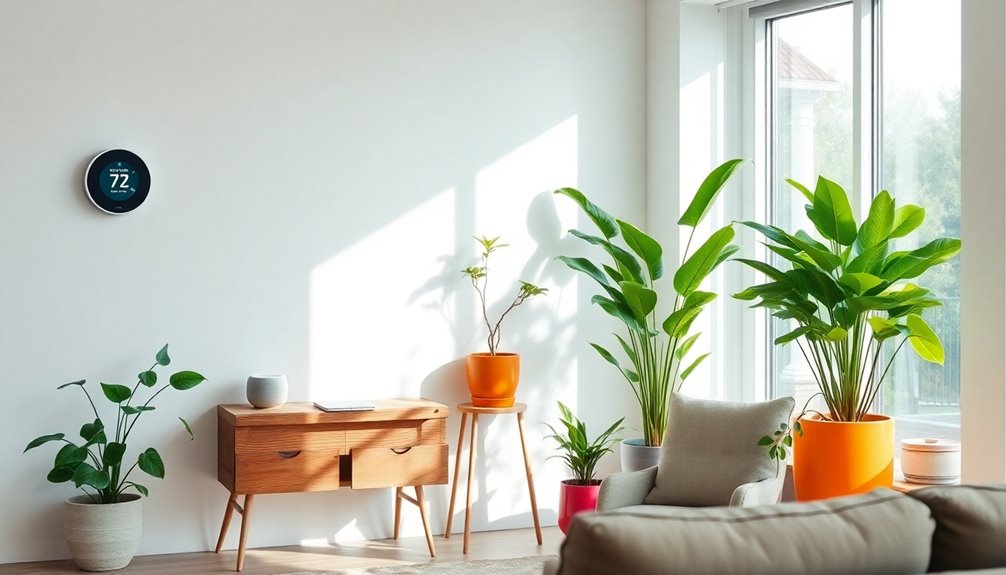
To make your home more eco-friendly, consider investing in smart home technology.
Smart thermostats can learn your routine and cut heating and cooling costs considerably, while energy monitoring systems help you track usage and identify waste. Additionally, many smart home security systems offer integration with smart home devices, allowing you to enhance energy efficiency while ensuring your home is secure.
Smart Thermostats Efficiency
As you embrace smart home technology, consider how a smart thermostat can greatly enhance your energy efficiency. By learning your schedule, these devices can reduce heating and cooling costs by up to 10-15%.
Plus, with remote control via your smartphone, you can manage your home's temperature even when you're away.
Here are three benefits of using a smart thermostat:
- Geofencing: Automatically adjusts the temperature based on your location, preventing energy waste when you're not home.
- Integration: Works with other smart devices, optimizing overall energy use.
- Energy Reports: Provides insights into your energy consumption, helping you spot savings opportunities.
Moreover, utilizing a smart thermostat can complement the advancements in heat pump technology that enhance overall system efficiency.
Making this upgrade not only saves you money but also contributes to a more eco-friendly home.
Energy Monitoring Systems
While you may already be using smart devices to enhance your home, integrating energy monitoring systems takes your eco-friendly efforts to the next level.
These systems track real-time energy usage, helping you identify where to cut back and save on energy bills. Many smart monitors provide insights into individual appliance consumption, so you can prioritize upgrades for your most energy-hungry devices.
By connecting with your smart home technology, these systems automate energy-saving actions like adjusting thermostat settings or turning off lights in unoccupied rooms.
Plus, they alert you to unusual energy spikes, allowing you to quickly address issues like faulty appliances.
Utilizing energy monitoring can reduce your consumption by 10-15%, considerably lowering your carbon footprint. Additionally, incorporating a heat pump system can further enhance energy efficiency in your home, maximizing your eco-friendly efforts.
Implement Rainwater Harvesting
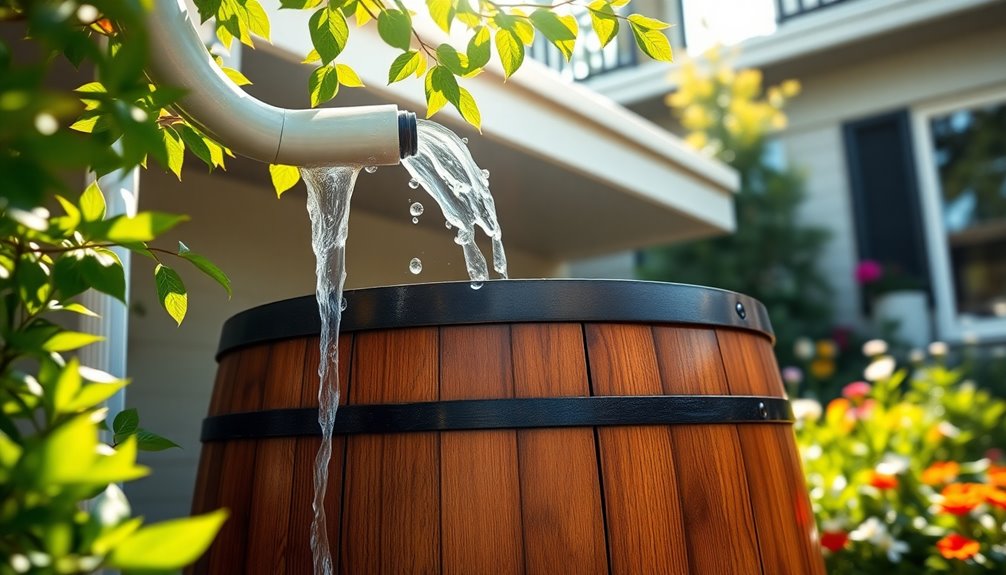
Implementing rainwater harvesting not only conserves water but also helps you create a sustainable home environment. By capturing and storing rainwater, you can greatly reduce your dependence on municipal water supplies.
Here are three benefits of installing a rainwater harvesting system:
- Save Water: You can save up to 1,300 gallons during peak summer months, perfect for irrigation and gardening.
- Sustainable Use: A well-designed system can meet about 50% of your household's outdoor water needs, like washing cars and watering plants.
- Natural Fertilizer: Rainwater is soft and chemical-free, promoting healthier plant growth without the need for chemical fertilizers.
Plus, check for local incentives that make this eco-friendly solution even more cost-effective!
Improve Home Insulation
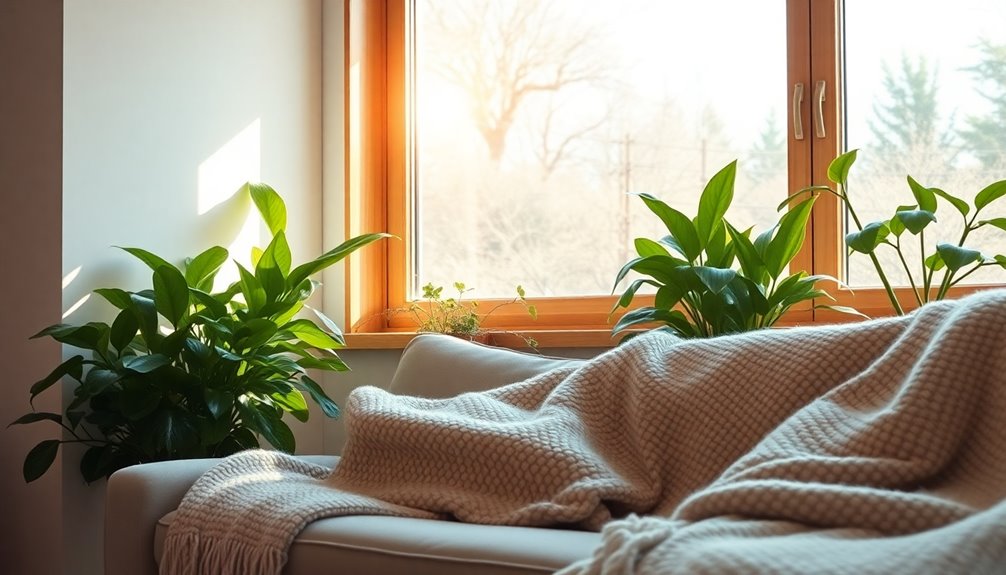
To boost your home's energy efficiency, start by sealing air leaks around windows and doors.
This simple step can keep drafts out and save you money on heating and cooling costs.
Next, consider upgrading to better insulation materials for even greater thermal resistance and comfort throughout the year. Additionally, ensure proper ventilation systems are in place to maintain good air quality while preventing dangerous gas buildup.
Seal Air Leaks
Sealing air leaks is an essential step in enhancing your home's insulation and can lead to significant savings on heating and cooling costs.
By preventing conditioned air from escaping and unconditioned air from entering, you could reduce energy bills by up to 20%.
To effectively seal air leaks, focus on these common areas:
- Windows and Doors: Check for gaps around frames and use weatherstripping or caulk for sealing.
- Electrical Outlets: Install outlet gaskets to limit air flow.
- Pipes and Vents: Inspect where they pass through walls; seal any cracks with appropriate materials.
Perform a simple candle test near these areas—if the flame flickers, you've found a leak that needs addressing.
Regular maintenance guarantees lasting energy efficiency. Additionally, improving insulation can further enhance your home's performance by reducing energy consumption and maximizing the benefits of your heat pump system.
Upgrade Insulation Materials
After sealing air leaks, the next step in enhancing your home's energy efficiency is upgrading your insulation materials.
Consider using cellulose insulation made from recycled paper, which can reduce energy loss by up to 30%.
If you want superior air sealing, spray foam insulation can boost energy efficiency by up to 50% compared to fiberglass.
In warmer climates, installing reflective insulation in attics helps lower cooling costs by deflecting radiant heat.
You can also choose natural materials like sheep's wool or cotton, which improve thermal performance and emit fewer VOCs, creating a healthier indoor environment.
Proper insulation not only saves you money but also cuts greenhouse gas emissions, promoting a more sustainable lifestyle.
Make the switch today!
Select Low VOC Products
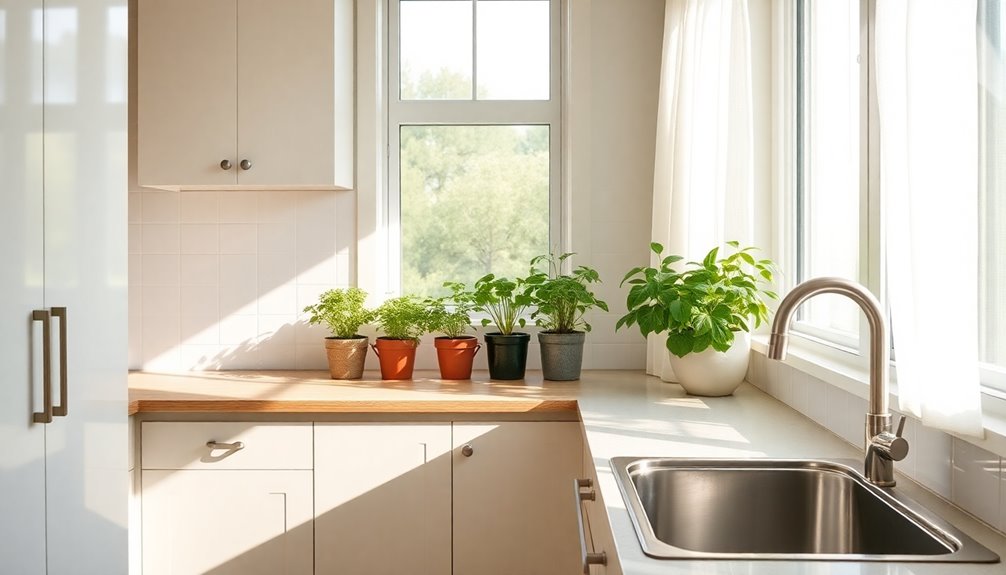
Choosing low VOC products is a smart way to enhance your home's air quality and overall safety.
These products, like low VOC paints and finishes, reduce harmful emissions that can lead to respiratory issues, making your space healthier—especially for kids and pets.
Plus, many manufacturers now offer low VOC alternatives that perform just as well as traditional options.
Here are three tips to help you select low VOC products:
- Check for Certifications: Look for labels like Green Seal or Greenguard to guarantee they meet strict low VOC standards.
- Research Brands: Choose manufacturers known for their commitment to eco-friendly practices.
- Read Product Labels: Always review labels for VOC content to make informed choices.
Making these selections contributes to a healthier environment for you and your community.
Maintain HVAC Systems Regularly
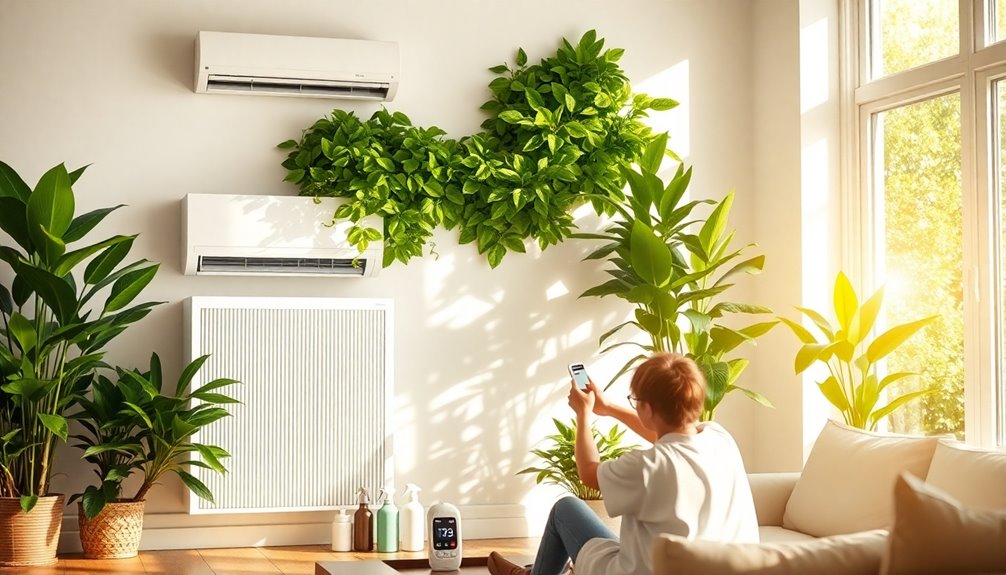
To keep your home comfortable and energy-efficient, regular maintenance of your HVAC system is essential.
Start by changing or cleaning the filters every month; this can boost efficiency by up to 15%, lowering your energy bills.
Schedule annual professional maintenance to catch and fix issues early, ensuring your system runs effectively.
Keep the outdoor unit clear of debris and vegetation to enhance airflow, improving efficiency by as much as 20%.
Don't forget to seal and insulate your ductwork to prevent up to 30% energy loss.
Finally, invest in a programmable thermostat to automatically adjust temperatures based on your schedule, potentially reducing energy usage by an additional 10%.
These simple steps can greatly improve your home's eco-friendliness.
Support Eco-Friendly Brands
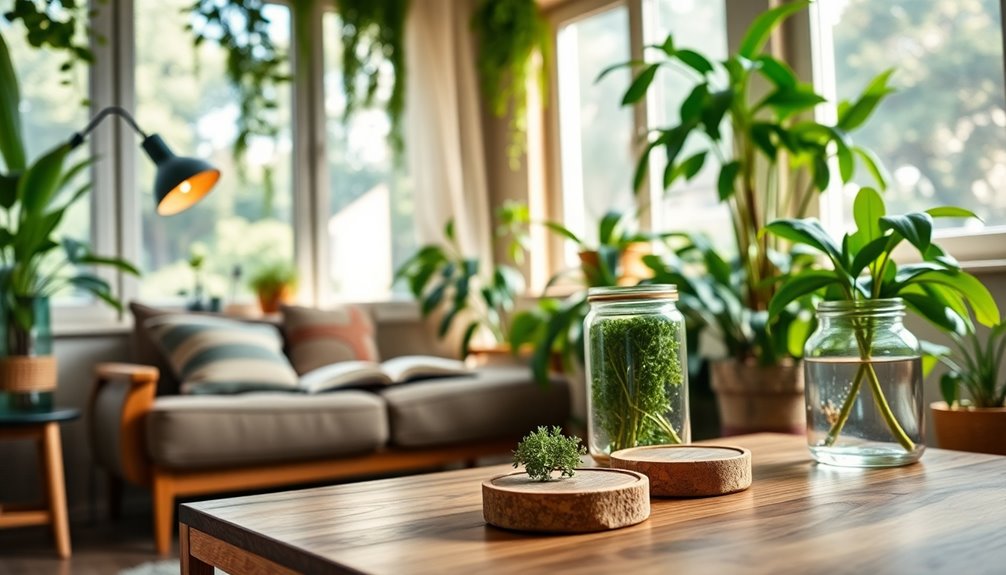
- Choose brands with sustainable materials: Look for products made from recycled or sustainably sourced components.
- Research supply chains: Select companies that are transparent about their sourcing practices and prioritize ethical labor.
- Opt for minimal packaging: Support businesses that use biodegradable materials or minimal packaging to reduce waste.
Additionally, consider supporting brands that collaborate with high-end designers to create eco-conscious collections, as these partnerships often emphasize sustainability and ethical production methods.
Frequently Asked Questions
How Can We Make Your Home More Environmentally Friendly?
You can make your home more environmentally friendly by switching to LED bulbs, which cut energy use considerably.
Consider installing low-flow toilets and water-saving faucets to reduce water consumption.
Opt for eco-friendly materials like bamboo or cork for your flooring, improving air quality.
In your landscaping, choose drought-tolerant and native plants to minimize water use.
Finally, support sustainable brands that prioritize eco-friendly materials and ethical practices, helping create a greener market.
How Can I Be 100% Eco-Friendly?
To be 100% eco-friendly, you need to make conscious choices daily.
Start by using low VOC paints and finishes to improve air quality. Choose energy-efficient appliances and LED bulbs to save energy.
Install low-flow toilets to conserve water, and landscape with native plants to reduce maintenance.
Finally, support sustainable brands that prioritize eco-friendly materials.
How Do I Build a Cheap Eco-Friendly House?
Building a cheap eco-friendly house is like crafting a masterpiece with nature's palette.
Start by using reclaimed materials like wood and bricks to cut costs and lessen your environmental footprint. Incorporate solar panels for renewable energy, which can save you money long-term.
Choose natural insulation materials for efficiency and design your home with large south-facing windows to capture sunlight. A compact layout maximizes space while minimizing resource use, keeping your ecological impact light.
How Do I Make My House More Eco-Friendly Sims 4?
To make your house more eco-friendly in Sims 4, start by using sustainable building materials like bamboo or reclaimed wood.
Add solar panels and wind turbines for renewable energy.
Plant drought-tolerant and native plants in your garden to save water and enhance biodiversity.
Equip your home with energy-efficient appliances and LED lighting, and install water-saving fixtures like low-flow toilets.
These steps will help you create a more sustainable living environment for your Sims.
Conclusion
By making these eco-friendly changes, you're not just saving the planet—you're becoming a superhero in your own home! Imagine transforming your space into a green fortress that fights off waste and saves energy faster than a speeding bullet. With every sustainable choice, you're not just helping the Earth; you're setting an example for your friends and family. So go ahead, release your inner eco-warrior and watch your home flourish into an eco-paradise that even Mother Nature would envy!
